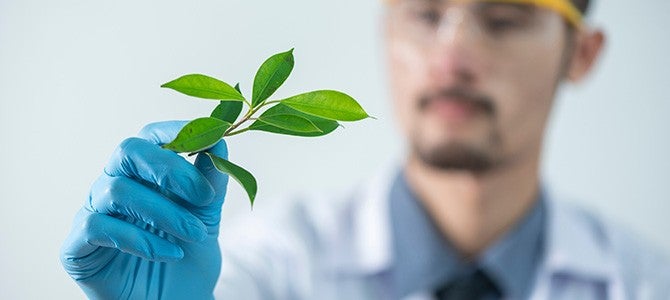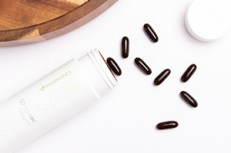What is Bioavailability of Dietary Supplements?
September 11, 2020

Have you heard of the term bioavailability before? Bioavailability is how much you absorb and utilize nutrients from food or supplements. Absorption is what gets in your body, but then your body must be able to utilize it. You’ve heard the saying you are what you eat, right? Well, it’s more accurate to say you are what you absorb and utilize. Therefore, bioavailability is the key to understanding how nutrients work in the body for your health and getting the most out of foods and supplements.
The bioavailability of nutrients involves many factors, including the form of a nutrient, nutrient interactions, the concentration of a nutrient, your health status, your age and genetics, and much more1. Nu Skin’s Pharmanex has a team of brilliant scientists to interpret the scientific literature and leverage this science for our product formulations. Let’s dive into just a few of these bioavailability factors through some examples.
Nutrient Forms:
Many vitamins and minerals, and even phytonutrients, come in several different forms with varying degrees of bioavailability. Given that there are so many variables that affect bioavailability, we cannot assume that one form of a vitamin or mineral or other nutrients in a dietary supplement will be absorbed to the same degree as another2. Therefore, Pharmanex scientists take careful consideration when reviewing a dietary supplement; minor differences in forms or amounts or combinations of nutrients can have an impact on how your body receives and benefits from good nutrition.
Let’s consider vitamin E. Is synthetic vitamin E the same as natural vitamin E? No. In fact, they are quite different. Natural α-tocopherol (vitamin E) comes in the form that the body absorbs and uses effectively. Synthetic α-tocopherol (vitamin E) comes in eight different forms of the same nutrient. The problem is that only half of the forms in synthetic α-tocopherol are utilized in the body, so synthetic α-tocopherol is less bioavailable than natural α-tocopherol3.
What about vitamin D? There are two forms of vitamin D: Vitamin D2 and Vitamin D3. The science shows that vitamin D2 is less effective than vitamin D3. In this regard, vitamin D3 is the preferred choice for supplementation. How is it better you ask? Vitamin D3 is more effective than vitamin D2 in increasing and maintaining higher serum concentrations of 25-hydroxyvitamin D, which is a biomarker of vitamin D status4.

Vitamin K is another interesting example that is present in different forms: vitamin K1 and vitamin K2. The slight difference in structure between vitamin K1 and K2 is seen in different absorption rates, tissue distribution and effects, and of course bioavailability5. Studies show that both vitamin K1 and K2 are readily absorbed within a few hours after ingestion. However, in one study, the circulating concentrations of vitamin K2 (as MK-7) were up to 10-times higher than vitamin K1 in serum6. This highlights that vitamin K2 is available for longer in the blood, which allows it to be utilized by tissues in the body; in other words, it’s more bioactive.
Even amongst the different forms of vitamin K2, there are differences in bioavailability. Vitamin K2 is a family of slightly different forms that are designated as MK-4 through MK-13. Of all the forms of vitamin K2, MK-7 is absorbed most efficiently and has the greatest bioavailability7.
Nutrient interactions:
Nutrients are not isolated compounds that do their own thing. Most nutrients are web-like in their interactions, so to optimize nutrients in the body, it’s important to consider how nutrients interact. One of the best-known examples of these interactions is with calcium and vitamin D. Vitamin D promotes calcium absorption from the intestine and maintains adequate serum levels of calcium in the body. Other nutrients that work in this web either directly or indirectly include magnesium, silicon, phosphorus, boron, and vitamin K. Therefore, a formula to support bone health needs to contain more than just calcium or just vitamin D; these nutrients by themselves are not enough to fully support the complex interactions of nutrients in the body for good bone health.

Another notable example of nutrient interactions can be found with antioxidants. Antioxidants work together to optimize their activity in the body, so one antioxidant is not enough to get complete protection. If Vitamin E is oxidized by a free radical it can be regenerated by vitamin C. In the process of regenerating Vitamin E, Vitamin C is now oxidized. Vitamin C can be regenerated by glutathione or Alpha Lipoic Acid. The chain reaction of antioxidants coming to the rescue to regenerate others goes on, but this is a classic example of how nutrients interact to maximize their benefits in the body. This is why a blend of antioxidants provides more protection than a single antioxidant can9.
Carotenoids are powerful antioxidants found in many colorful fruits and vegetables like peppers, tomatoes, carrots, spinach, and more. But did you know that carotenoids generally have poor bioavailability? For carotenoids to be absorbed, they need to be released from the food matrix. Therefore, processing or gently cooking certain foods can often help release carotenoids embedded in their food matrix10. Additionally, carotenoids are fat-soluble, so eating a source of fat with carotenoids helps improve absorption as well. One study showed that two carotenoids, lycopene, and β-carotene, were better absorbed when taken with a source of fat (avocado in this example) than after consumption of carotenoids alone. In fact, the carotenoids with a fat source were shown to be 4.4 and 2.6 times better absorbed for lycopene and β-carotene respectively on average compared to the same carotenoids without some fat11.
Conclusion:
This is a brief overview of just some of the principles of bioavailability, but it gives a glimpse of the complexity that goes into formulating a bioavailable supplement. Pharmanex scientists have incorporated all of the ingredients mentioned in our various products and continue to make updates to our product lines. As science evolves our commitment to innovation and providing the best of science remains true to each product delivered to your door. So, what does this all mean to you? It means that you can trust Pharmanex for your dietary supplement needs, knowing that we have many options of supplements based on science, innovation, and of course ensuring that you absorb and utilize these ingredients to support your journey of health and wellness.
References:
- Pressman, P., Clemens, A. R., Hayes, A. W. (2017). Bioavailability of micronutrients obtained from supplements and food: A survey and case study of the polyphenols. Toxicology Research and Application, 1, 1-7
- Comerford KB. Recent developments in multivitamin/mineral research. Adv Nutr. 2013;4(6):644-656. Published 2013 Nov 6. doi:10.3945/an.113.004523
- Institute of Medicine. 2000. Dietary Reference Intakes for Vitamin C, Vitamin E, Selenium, and Carotenoids. Washington, DC: The National Academies Press. doi: 10.17226/9810
- Itkonen ST, Skaffari E, Saaristo P, et al. Effects of vitamin D2-fortified bread v. supplementation with vitamin D2 or D3 on serum 25-hydroxyvitamin D metabolites: an 8-week randomised-controlled trial in young adult Finnish women. Br J Nutr. 2016;115(7):1232-1239.
- Schurgers L.J., Vermeer C. Determination of Phylloquinone and Menaquinones in Food. Pathophysiol. Haemost. Thromb. 2001;30:298–307. doi: 10.1159/000054147
- Schurgers L.J., Teunissen K.J.F., Hamulyák K., Knapen M.H.J., Vik H., Vermeer C. Vitamin K-containing dietary supplements: Comparison of synthetic vitamin K1 and natto-derived menaquinone-7. Blood. 2007;109:3279–3283. doi: 10.1182/blood-2006-08-040709
- Sato T, Schurgers LJ, Uenishi K. Comparison of menaquinone-4 and menaquinone-7 bioavailability in healthy women. Nutr J. 2012;11:93. Published 2012 Nov 12. doi:10.1186/1475-2891-11-93
- Holick MF. Vitamin D: A millenium perspective. J Cell Biochem. 2003;88(2):296-307
- Packer L, Valacchi G. Antioxidants and the response of skin to oxidative stress: vitamin E as a key indicator. Skin Pharmacol Appl Skin Physiol. 2002;15(5):282-290. doi:10.1159/000064531
- Reboul E., Richelle M., Perrot E., Desmoulins-Malezet C., Pirisi V., Borel P. Bioaccessibility of carotenoids and vitamin e from their main dietary sources. J. Agric. Food Chem. 2006;54:8749–8755. doi: 10.1021/jf061818s Unlu NZ, Bohn T, Clinton SK, Schwartz SJ. Carotenoid absorption from salad and salsa by humans is enhanced by the addition of avocado or avocado oil. J Nutr. 2005 Mar;135(3):431-6
- Unlu NZ, Bohn T, Clinton SK, Schwartz SJ. Carotenoid absorption from salad and salsa by humans is enhanced by the addition of avocado or avocado oil. J Nutr. 2005 Mar;135(3):431-6
-
The human brain uses a tremendous amount of energy every day. This energy is important for normal brain functions like thinking and remembering information and events. The process of accessing that energy creates damaging compounds (called free radicals or reactive oxygen species) as a byproduct. This means that our brains need a lot of antioxidants every day to protect against these damaging mole...
-
Working from home. It’s something many of us have become more familiar with earlier this year. Whether it is your first experience with working remotely or you’re a seasoned work-from-home expert, we could all use a little extra advice to help us stay productive and focused. Here are nine tips and tricks from the experts to help you avoid work burnout and find balance, so you can actually thrive w...

